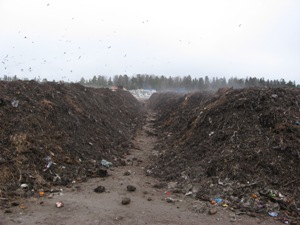Greenhouse gas, acidifying and eutrophying emissions from compost and composting
Composting is the dominating biological treatment method for household and garden waste in Sweden, and is even more prevalent at European and global scales. The emissions of greenhouse gases and ammonia are decisive for the evaluation of the environmental impact of the process.
Different authors report highly divergent levels of emissions occurring during composting. For instance the emissions of the strong greenhouse gas methane (CH4) can vary between 0% and 4%, and in static pile composting even 12% of initial volatile solids. The emissions of the very strong green house gas nitrous oxide (N2O) are reported to vary between 1% and 4%, and in static piles even 10% of initial nitrogen. The large variation in the reported values indicates that the potential for decreasing the emissions by process optimization can be large. Considering that the global warming potential over 100 year time horizon (GWP) of CH4 is 25 times as strong as carbon dioxide, and the GWP of N2O is 298. Even a small improvement in operation conditions can substantially improve the environmental performance of composting.
Both ammonia (NH3) and nitrogen oxides (NOx) emissions have acidifying and eutrophying effects. In the composting process considerable amount of nitrogen is mineralized, so the emissions of NH3 and NOx can be large and they are influenced by process parameters.
The results of this project will include knowledge on the emissions from composting, a better understanding of the influence of composting conditions on green house gas emissions, suggestions for mitigation of these emissions, and well founded knowledge on how composting compares with anaerobic digestion and waste incineration from an environmental point of view.
Project leader: Håkan Jönsson
Co-workers:Mikael Pell, Cecilia Sundberg, Francesco Agostini, Evgheni Ermolaev
Project period:2008-2012
Financing: FORMAS, SLU
Links

Photo by Evgheni Ermolaev, 2009